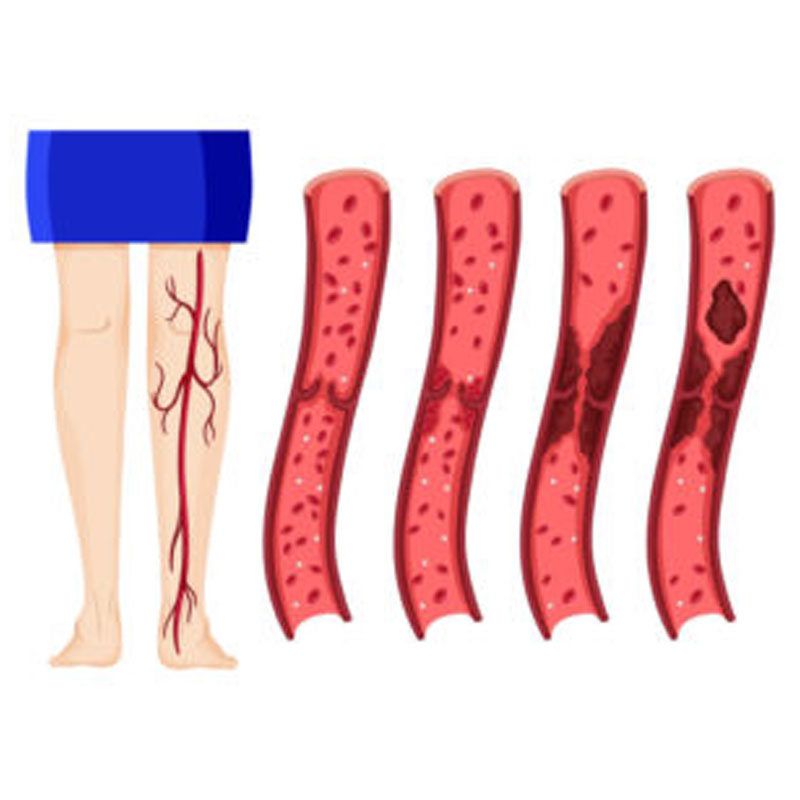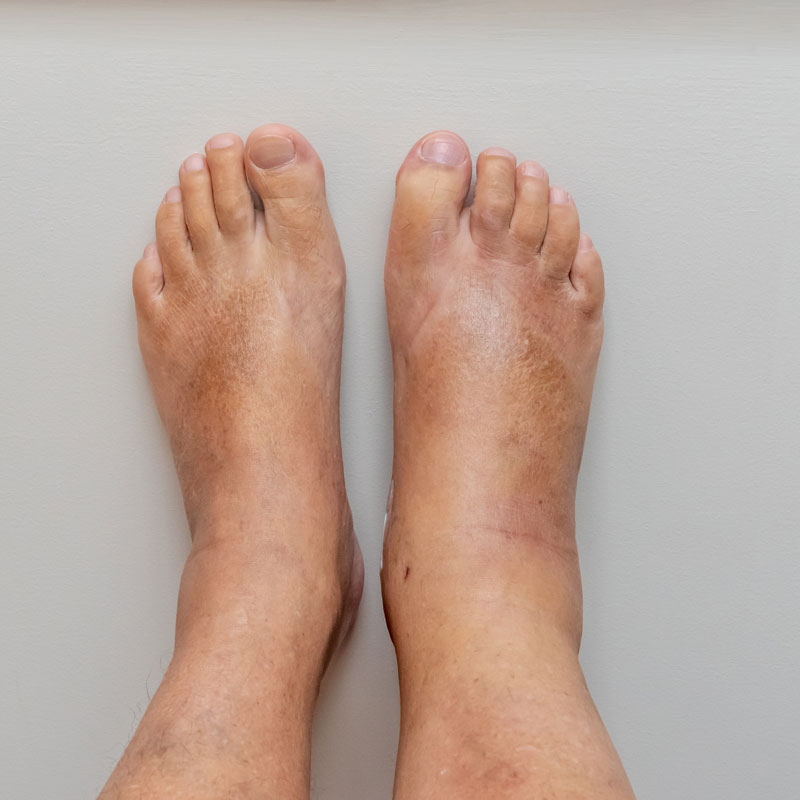Deep Vein Thrombosis (DVT)
We Offer Treatment for Blood Clots in Veins
Arizona Vein & Laser Institute provides deep vein thrombosis (DVT) treatment to patients throughout Arizona. Whether you’re in Phoenix, Glendale, Chandler, Surprise, Avondale, or Scottsdale, we’ve got you covered. Read on to learn more about DVT, its causes, symptoms, and available treatment options.
What is Deep Vein Thrombosis?
Deep vein thrombosis (DVT) is a condition caused by the formation of a blood clot located within a deep vein. DVT typically occurs in the thigh or lower leg but has been known to occur in other parts of the body as well. If left undiagnosed and untreated, DVT can cause severe damage to other blood vessels and internal organs, putting an individual at high risk for death.
The Causes of Deep Vein Thrombosis
DVT is caused by a blood clot in a deep vein, usually in the thigh or leg. Various factors, including pregnancy, obesity, smoking, a broken bone near a major vein, or a prolonged sedentary lifestyle, can cause a DVT blood clot. DVT is often difficult to identify and diagnose due to its symptomatic similarities with other conditions. Reach out today to learn more about DVT causes.

The Symptoms of Deep Vein Thrombosis
DVT symptoms can vary slightly from person to person. Common symptoms of DVT include, but are not limited to, the following:
- Swelling in the lower extremities, usually on a single side
- Cramping, usually beginning in the calf
- Severe and sudden pain in the foot or ankle
- Increased warmth in a localized area of the skin
- A reddish or bluish color change to a localized area of the skin

Obtaining a DVT Diagnosis
If you are suffering from any of the above symptoms, it is important to meet with a medical professional as soon as possible. The longer DVT is left undiagnosed and untreated, the greater an individual’s risk for organ damage and untimely death. At Arizona Vein & Laser Institute, we offer comprehensive diagnosis and treatment procedures for patients suffering from DVT in all areas of the body.
We typically diagnose DVT by performing a physical examination during which a patient will be asked questions about their medical history. A pain-free ultrasound will then be performed to detect the presence of blood clots. We may also recommend venography, a procedure where dye is injected into the body to better identify blood clots. Reach out today to learn more about obtaining a DVT diagnosis.
We Offer Professional DVT Treatment Options
At Arizona Vein & Laser Institute, we offer multiple DVT treatment options, including thrombolysis, thrombectomy, and venoplasty. The type of treatment that is best suited for you and your unique needs will depend on the severity and location of your clot. For small blood clots, patients are prescribed blood thinners. For larger, more severe clotting, one of the three following methods may be used to treat DVT:
Thrombolysis
Thrombolysis is a procedure that helps to dissolve dangerous blockages in blood vessels through drugs administered via IV injection, preventing damage to tissues and organs.
Thrombectomy
Larger and more severe blood clots must often be surgically removed to fully restore circulation and prevent further damage to surrounding tissues and organs.
Venoplasty
This procedure uses an inflatable balloon to widen veins and improve blood flow, alleviating the blockage caused by a blood clot. Often, a stent is used in tandem with a venoplasty.
Deep Vein Thrombosis Treatment in Arizona
Invest in sustainable comfort and health with Arizona Vein & Laser Institute. Our vein specialists provide deep vein thrombosis treatment to patients throughout Arizona. Whether you’re in Phoenix, Glendale, Chandler, Avondale, or Scottsdale, we have you covered with the highest standard of advanced blood clot and vein treatment.
Deep vein thrombosis symptoms vary from one patient to the next. Deep vein thrombosis symptoms may include:
- Swelling in the lower extremities, usually on a single side
- Cramping, often beginning in the calf
- Increased warmth in a localized area of the skin
- Reddish or blueish discoloration to a localized area of the skin
What is deep vein thrombosis (DVT)? DVT is the result of a deep vein blood clot, usually in the thigh or leg. These blood clots can be caused by a number of factors, including:
- Injury or accident
- Blood disorders
- Insufficient blood flow due to bedrest post-surgery
- Recent birth or pregnancy
- Obesity
- Smoking
- Prolonged sedentary lifestyle
- Certain medications
- Certain types of cancer
Patients experiencing DVT generally demonstrate key symptoms indicative of the condition. To diagnose DVT, your physician will assess your symptoms and conduct a physical exam. Furthermore, your physician may refer you for an ultrasound to evaluate the blood flow within the veins. Subsequent imaging tests may also be conducted to confirm your DVT diagnosis.
The duration of blood thinner medication varies. The majority of patients with DVT will be placed on blood thinners for six months. However, those who developed DVT as a result of one identified cause, such as surgery, may not have external risk factors, reducing their blood thinners prescription plan.
Deep vein thrombosis treatment is proven safe and highly effective in mitigating symptoms and associated risks of DVT. Though typically mild and tolerable, it is possible to experience lasting effects post-treatment. The common side effects of deep vein thrombosis treatment include periodic swelling, discomfort, and skin discoloration around the clot site.
Deep vein thrombosis (DVT) is not a type of blood clot that gravitates toward the heart or brain and is not associated with heart attack or stroke. In contrast, arterial thrombosis, which is a clot in an artery rather than a vein, elevates the risk of heart attack and stroke.
The risk of developing a subsequent DVT after pursuing deep vein thrombosis treatment depends on the cause of the initial DVT. Approximately one-third of patients with DVT will experience a second DVT within 10 years of the first DVT. Mitigating this risk depends on the underlying cause.
Preventing DVT depends on the cause of your condition. If you develop DVT post-surgery, with no additional risk factors, you are unlikely to have it again. Those with DVT as a result of inherited blood disorders or age cannot prevent DVT entirely. However, there are preventative strategies that can reduce the risk of DVT.
Prioritizing a healthy lifestyle is the first line of defense against DVT. To reduce your risk of DVT, we recommend:
- Maintain a healthy weight
- Get active and incorporate regular exercise into your routine
- Avoid sitting for extended periods
- Stop to move your legs during long car rides
Contact Our Team Today for DVT Treatment
At Arizona Vein & Laser Institute, patients throughout Arizona can expect state-of-the-art treatment and care. To learn more about DVT treatment or to schedule an appointment with our medical professionals, contact us today. We look forward to providing you with premier services and treatment options.
Customer Reviews
I have been going to Dr Sharma for many years. I highly recommend him for any vein issues. He’s very professional and so is his staff!
I've been getting treatment for about a year. I had another issue that stopped treatment for a few months. Everyone was very understanding and concerned about my well-being. When I was able to return, everyone remembered me and ask how things went. I've made massive improvements in my veins and friends that I cherish.
